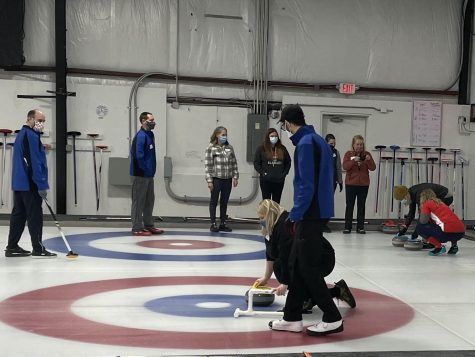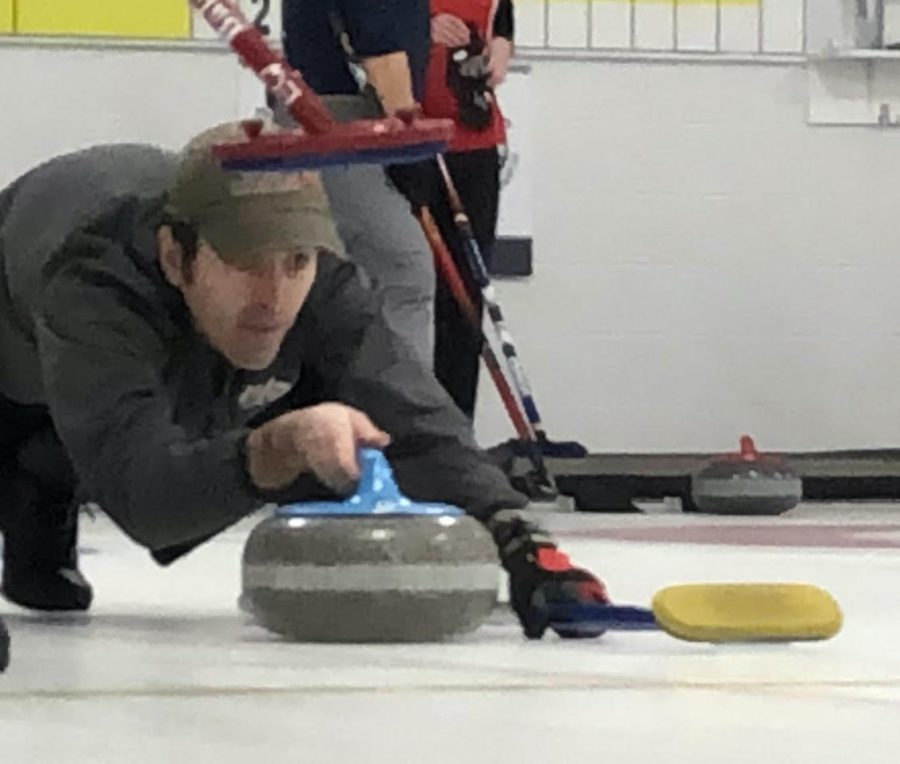Curling surges in popularity after Winter Olympics
Photo provided by the Cincinnati Curling Club
A player at the Cincinnati Curling Club takes careful aim before sliding his stone down the ice.
March 11, 2022
Curling, a sport that seems to combine bowling and shuffleboard, played with heavy granite stones and brooms – on ice – surges in popularity every four years when millions see it televised during the Winter Olympic Games.
Curling can be both a fun game to play with friends and a brilliantly strategic, highly competitive sport. Both recreational and competitive curling involves a good amount of physical activity.
“It’s more physically challenging than people realize, especially at the higher level,” said Dean Gemmell, USA Curling’s director of growth and development. “It takes more athletic ability than people realize and certainly if you see the teams in the Olympics nowadays, they’re all physically fit.”
Curling sheets, the surfaces the games are played on, are lanes of ice, 146 to 150 feet long and 14.5 to 16.5 feet wide. There is a target – called a house – at each end consisting of a series of concentric circles. The idea is to slide the stones down the ice and score points by ending up closest to the center of the house.
The stones weigh 38 to 44 pounds, are at least 4.5 inches thick and can be a maximum of 36 inches in circumference. These stones have handles sticking out of the top. Each team has four players and each player has two stones.
When a player slides a stone, two teammates use brooms or brushes to sweep the ice in front of it, helping it slide straighter and longer. Without the sweeping, stones may arc or curve – or curl – which gives the sport its name.
Oh, and despite being played on ice, players wear shoes, not skates.
How or why anyone came up with this game has been lost in the mists of time, but there are historical accounts of it being played in Scotland as early as the 1500s.
Curling at the Olympics is the highest level of competitive curling and takes years of training and practice, although some curlers come to the game later in life.
Ann Swisshelm, a two-time Olympic curler born in Middletown, didn’t start competitive curling until after her retirement, when she saw it in the 2014 Olympic Games in Sochi, Russia. She still finds lots of time to play the sport recreationally.
“I mean, basketball, swimming, diving, softball, I played every other sport competitively,” said Swisshelm. “Curling, I competitively curled later in life, but now I play Monday nights with my girlfriends and Thursday nights with my husband and some other friends, you know it’s amazing.
When she started curling, Swisshelm was living in the Chicago area. Jonathan Penney, who knows Swisshelm through the sport, is president and the ice technician for the Cincinnati Curling Club, based in West Chester, which regularly hosts learn-to-curl events.
“We’ve got certified instructors that’ll teach you everything you need to know about the game, and we have a real good handle on what (different) people want out of the game,” said Penney. “We can provide all those types of groups an opportunity to try it, and we almost warn people be careful when you try it because you might be hooked, you might be addicted.”
The curlers at the Olympic level are so talented that they make the sport appear easy, although to play at that level is extremely difficult. However, when it comes to learning to play, Swisshelm, Penney, and Gemmell all emphasized how it’s a game that can be learned at any age and can be played far into adulthood no matter the skill level.
Swisshelm attended the Olympics in China last month, where she worked as a broadcaster for Olympic Broadcast Services on the World Feed as a curling commentator. She said that in her commentating she tries to target the viewer who has never seen curling before and knows nothing about the sport.

“I try to pretend that I am talking to someone who is watching for the first time,” she said. “It can make the diehards, you know the curling fans, a little frustrated because it’s maybe not as high level as it could be. But when you are literally bringing curling into homes around the world for the first time, you have to make it accessible and finding that balance is pretty hard.”
With curling no longer dominating airtime on the sports channels across the country, an option for the Oxford community to access the sport is through the Cincinnati Curling Club. That facility is specifically dedicated to curling, with a passionate, dedicated man in Penney running the show.

On ice closer to Oxford, there are curling sheets at the end of the practice rink in Miami’s Goggin Ice Center. The limited number of intramural curling events at Goggin are restricted to Miami students, staff and faculty.
Curling doesn’t have as many followers as other sports in the U.S., but those who play are as passionate about it when compared to any other athlete and their respective sport. Gemmell and USA Curling are constantly looking to grow the game, and the Cincinnati Curling Club is a great close spot for members of the Oxford community to try a new fun and competitive sport for the first time.
“It is truly a great sport,” says Swisshelm. “And you can be super athletic, you know the most athletic human being on earth and totally get into the game, or you can be the person who says they don’t like sports and find the art of curling is super compelling.”














